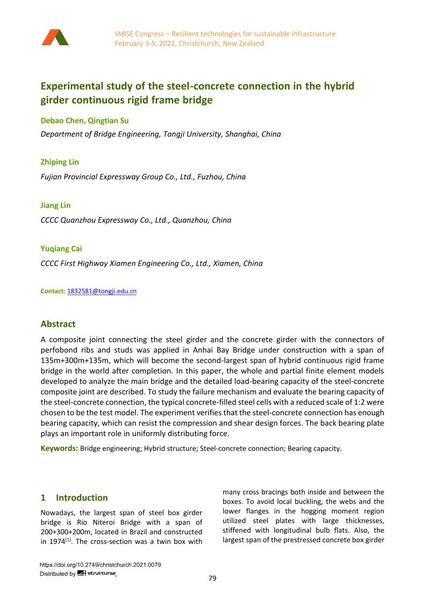Experimental study of the steel-concrete connection in the hybrid girder continuous rigid frame bridge

|
|
|||||||||||
Détails bibliographiques
| Auteur(s): |
Debao Chen
(Department of Bridge Engineering, Tongji University, Shanghai, China)
Qingtian Su (Department of Bridge Engineering, Tongji University, Shanghai, China) Zhiping Lin (Fujian Provincial Expressway Group Co., Ltd., Fuzhou, China) Jiang Lin (Fujian Provincial Expressway Group Co., Ltd., Fuzhou, China) Yuqiang Cai (CCCC First Highway Xiamen Engineering Co., Ltd., Xiamen, China) |
||||
|---|---|---|---|---|---|
| Médium: | papier de conférence | ||||
| Langue(s): | anglais | ||||
| Conférence: | IABSE Congress: Resilient technologies for sustainable infrastructure, Christchurch, New Zealand, 3-5 February 2021 | ||||
| Publié dans: | IABSE Congress Christchurch 2020 | ||||
|
|||||
| Page(s): | 79-87 | ||||
| Nombre total de pages (du PDF): | 9 | ||||
| DOI: | 10.2749/christchurch.2021.0079 | ||||
| Abstrait: |
A composite joint connecting the steel girder and the concrete girder with the connectors of perfobond ribs and studs was applied in Anhai Bay Bridge under construction with a span of 135m+300m+135m, which will become the second-largest span of hybrid continuous rigid frame bridge in the world after completion. In this paper, the whole and partial finite element models developed to analyze the main bridge and the detailed load-bearing capacity of the steel-concrete composite joint are described. To study the failure mechanism and evaluate the bearing capacity of the steel-concrete connection, the typical concrete-filled steel cells with a reduced scale of 1:2 were chosen to be the test model. The experiment verifies that the steel-concrete connection has enough bearing capacity, which can resist the compression and shear design forces. The back bearing plate plays an important role in uniformly distributing force. |
||||
